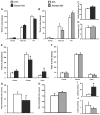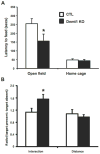Impact of DNMT1 and DNMT3a forebrain knockout on depressive- and anxiety like behavior in mice
- PMID: 27545441
- PMCID: PMC5050143
- DOI: 10.1016/j.nlm.2016.08.012
Impact of DNMT1 and DNMT3a forebrain knockout on depressive- and anxiety like behavior in mice
Abstract
DNA methylation has been shown to impact certain forms of synaptic and behavioral plasticity that have been implicated in the development in psychiatric disorders. DNA methylation is catalyzed by DNA methyltransferase (DNMT) enzymes that continue to be expressed in postmitotic neurons in the forebrain. Using a conditional forebrain knockout of DNMT1 or DNMT3a we assessed the role of these DNMTs in anxiety and depressive-like behavior in mice using an array of behavioral testing paradigms. Forebrain deletion of DNMT1 had anxiolytic and antidepressant-like properties as assessed by elevated plus maze, novelty suppressed feeding, forced swim, and social interaction tests. DNMT3a knockout mice, by contrast, did not exhibit significant behavioral alterations in these tests. Given the putative role of altered DNA methylation patterns in the development of schizophrenia, we also assessed DNMT1 and DNMT3a knockout mice in a prepulse inhibition task and found an enhanced prepulse inhibition of startle in DNMT1 knockouts relative to wild type mice, with no change evident in DNMT3a knockout mice. Our data suggest that DNMT1 and DNMT3a are distinctly involved in affective behavior and that DNMT1 may ultimately represent a potential target for treatment of certain affective behavioral disorders.
Keywords: Anxiety; Behavior; DNA methylation; Depression; Prepulse inhibition.
Copyright © 2016 Elsevier Inc. All rights reserved.
Figures




Similar articles
-
Selective role for DNMT3a in learning and memory.Neurobiol Learn Mem. 2014 Nov;115:30-7. doi: 10.1016/j.nlm.2014.06.005. Epub 2014 Jun 14. Neurobiol Learn Mem. 2014. PMID: 24937014 Free PMC article.
-
Dnmt1 and Dnmt3a maintain DNA methylation and regulate synaptic function in adult forebrain neurons.Nat Neurosci. 2010 Apr;13(4):423-30. doi: 10.1038/nn.2514. Epub 2010 Mar 14. Nat Neurosci. 2010. PMID: 20228804 Free PMC article.
-
Virus-mediated Dnmt1 and Dnmt3a deletion disrupts excitatory synaptogenesis and synaptic function in primary cultured hippocampal neurons.Biochem Biophys Res Commun. 2020 May 28;526(2):361-367. doi: 10.1016/j.bbrc.2020.03.094. Epub 2020 Mar 25. Biochem Biophys Res Commun. 2020. PMID: 32222282
-
DNA methyltransferases in hematological malignancies.J Genet Genomics. 2020 Jul 20;47(7):361-372. doi: 10.1016/j.jgg.2020.04.006. Epub 2020 Jul 24. J Genet Genomics. 2020. PMID: 32994141 Free PMC article. Review.
-
Molecular enzymology of mammalian DNA methyltransferases.Curr Top Microbiol Immunol. 2006;301:203-25. doi: 10.1007/3-540-31390-7_7. Curr Top Microbiol Immunol. 2006. PMID: 16570849 Review.
Cited by
-
Behavioral Tasks Evaluating Schizophrenia-like Symptoms in Animal Models: A Recent Update.Curr Neuropharmacol. 2021;19(5):641-664. doi: 10.2174/1570159X18666200814175114. Curr Neuropharmacol. 2021. PMID: 32798374 Free PMC article. Review.
-
DNMT1 downregulation as well as its overexpression distinctly affect mostly overlapping genes implicated in schizophrenia, autism spectrum, epilepsy, and bipolar disorders.Front Mol Neurosci. 2023 Dec 6;16:1275697. doi: 10.3389/fnmol.2023.1275697. eCollection 2023. Front Mol Neurosci. 2023. PMID: 38125006 Free PMC article.
-
Bacosides Encapsulated in Lactoferrin Conjugated PEG-PLA-PCL-OH Based Polymersomes Act as Epigenetic Modulator in Chemically Induced Amnesia.Neurochem Res. 2020 Apr;45(4):796-808. doi: 10.1007/s11064-020-02953-z. Epub 2020 Jan 20. Neurochem Res. 2020. PMID: 31960226
-
Antidepressant Effect of Sodium Butyrate is Accompanied by Brain Epigenetic Modulation in Rats Subjected to Early or Late Life Stress.Curr Neurovasc Res. 2024;20(5):586-598. doi: 10.2174/0115672026277345240115101852. Curr Neurovasc Res. 2024. PMID: 38288841
-
Role of DNMTs in the Brain.Adv Exp Med Biol. 2022;1389:363-394. doi: 10.1007/978-3-031-11454-0_15. Adv Exp Med Biol. 2022. PMID: 36350518 Review.
References
-
- Autry AE, Adachi M, Monteggia LM. Dynamic methylation driven by neuronal activity in hippocampal neurons impacts complex behavior. Frontiers in Biology. 2015;10:439–447.
-
- Baker-Andresen D, Ratnu VS, Bredy TW. Dynamic DNA methylation: a prime candidate for genomic metaplasticity and behavioral adaptation. Trends Neurosci. 2013;36:3–13. - PubMed
-
- Britton DR, Britton KT. A sensitive open field measure of anxiolytic drug activity. Pharmacol Biochem Behav. 1981;15:577–582. - PubMed
MeSH terms
Substances
Grants and funding
LinkOut - more resources
Full Text Sources
Other Literature Sources
Medical

